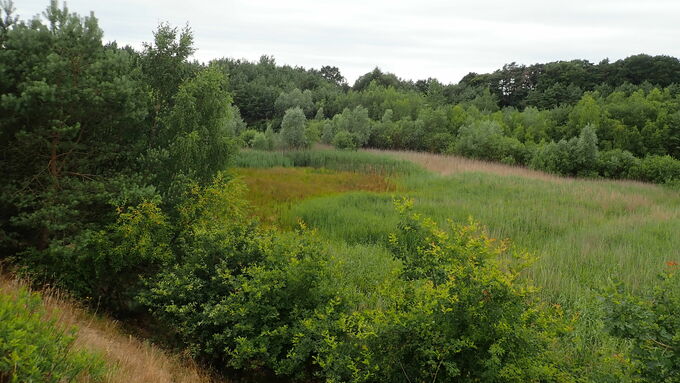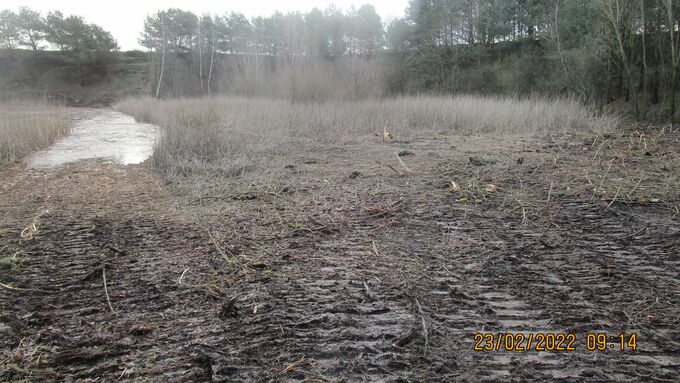Sand pit Wohlenbeck before the works started: Woody plants and reeds are spreading. © Kristof Meyn, NLWKN
download picturemain content
Project of the month
#6/2022 FORMER SAND PIT WOHLENBECK (DISTRICT OF CUXHAVEN)
Restoration and creation of new waterbodies and redevelopment of terrestrial habitats for the natterjack toad and the common spadefoot
The “Westerberg” is a mountain range in the north of the joint municipality of Börde Lamstedt, which reaches a maximum height of 66 metres. It is part of a series of terminal moraines of the Saale glacial period which begins with the Wingst ridge in the north and continues southwards with the Lamstedt terminal moraines. While the central area of the Westerberg is largely covered with mixed forest, the adjacent sandy ground moraines are mostly dominated by intensively used farmland. Due to the sandy deposits, there are also numerous sand pits, some of which have developed into important habitats for plant and animal species adapted to nutrient-poor, moist and alternating moist sites as well as to nutrient-poor standing waterbodies after the end of quarrying. This was also the case in an abandoned sand pit in the township of Wohlenbeck: After sand mining had ceased in 2001, a mosaic of permanent and temporary small waterbodies with vegetation of silted up areas, sun-exposed open soil areas, oligotrophic grassland and open woodland was able to develop here. These represent an important (partial) habitat for natterjack toads and common spadefoot toads, among others. Originally, the floodplains of the rivers, which are constantly changing due to flood dynamics, played an important role as habitat for both species. Today, about 50 percent of the occurrences are in secondary habitats such as gravel and sand pits or quarries, which is why these have become the most important habitats for the natterjack toad in Lower Saxony.
After the cessation of sand mining in the sand pit Wohlenbeck and its release into natural succession, pine stands quickly grew up. Despite the many years of effort by the NABU group Land Hadeln, led by the now deceased former chairman Fritz Bechinger, the open areas became visibly smaller and the formerly existing larger open water areas were progressively overgrown with reed beds. Due to the lack of water during the dry years from 2018 to 2020, the reproduction of the natterjack toad and the common spadefoot became even more difficult. The gradual overgrowth of the sand pit had a significant impact on the occurrence of the natterjack toad: In 2001, 250 juveniles and three adults could still be detected; spawn confirmed reproduction in the area at that time. In 2002, there were 30 juveniles, in 2004 35 juveniles and in 2011 only one adult. In 2017, no further evidence of the species was found. Although the failure of a successful metamorphosis over several years represents a high risk in a changing habitat, it does not have to mean the extinction of the population, given the high life expectancy of the natterjack toad of up to twelve years, as long as suitable habitats are created again in due time.
The Lower Nature Conservation Authority of the District of Cuxhaven and the LIFE IP Atlantic Region DE team at NLWKN recognised the urgent need for action to prevent the imminent extinction. Measures to restore amphibian habitats were to stabilise the local occurrences of the natterjack toad and the common spadefoot. After the NABU Foundation “Nationales Naturerbe” (National Nature Heritage) had acquired the area at the end of 2021, the implementation of measures began in February 2022. Under the guidance of an external ecological construction supervisor, the former spawning waterbody was deepened to improve the water flow and flattened. In a part of the restored waterbody which is separated from the main waterbody by a dam, a few square metres of rush stands were inserted to motivate the natterjack toad to spawn there as well. When removing emerging willows in the area of the main waterbody, this was slightly deepened. To redesign the terrestrial habitat, young pine trees were removed over several hundred square metres and raw soil areas were created. Using an excavator, the sand extracted in the course of the waterbody restoration was modelled into flat, easy-to-maintain mounds. These provide favourable microclimate sites for thermophilic species.
For the first time in years, this breeding season any remaining natterjack toads and common spadefoots will have adequate spawning waterbodies at their disposal. The newly created terrestrial habitat of about 3,300 square metres provides good feeding conditions for the natterjack toad in particular, as insects will also benefit from the measure and the amphibian species uses the open areas for hunting. The success of the action will be verified by an amphibian survey in 2023.
Related topics
- Overall objectives of the project
- Species profile – natterjack toad
- Species profile – common spadefoot





